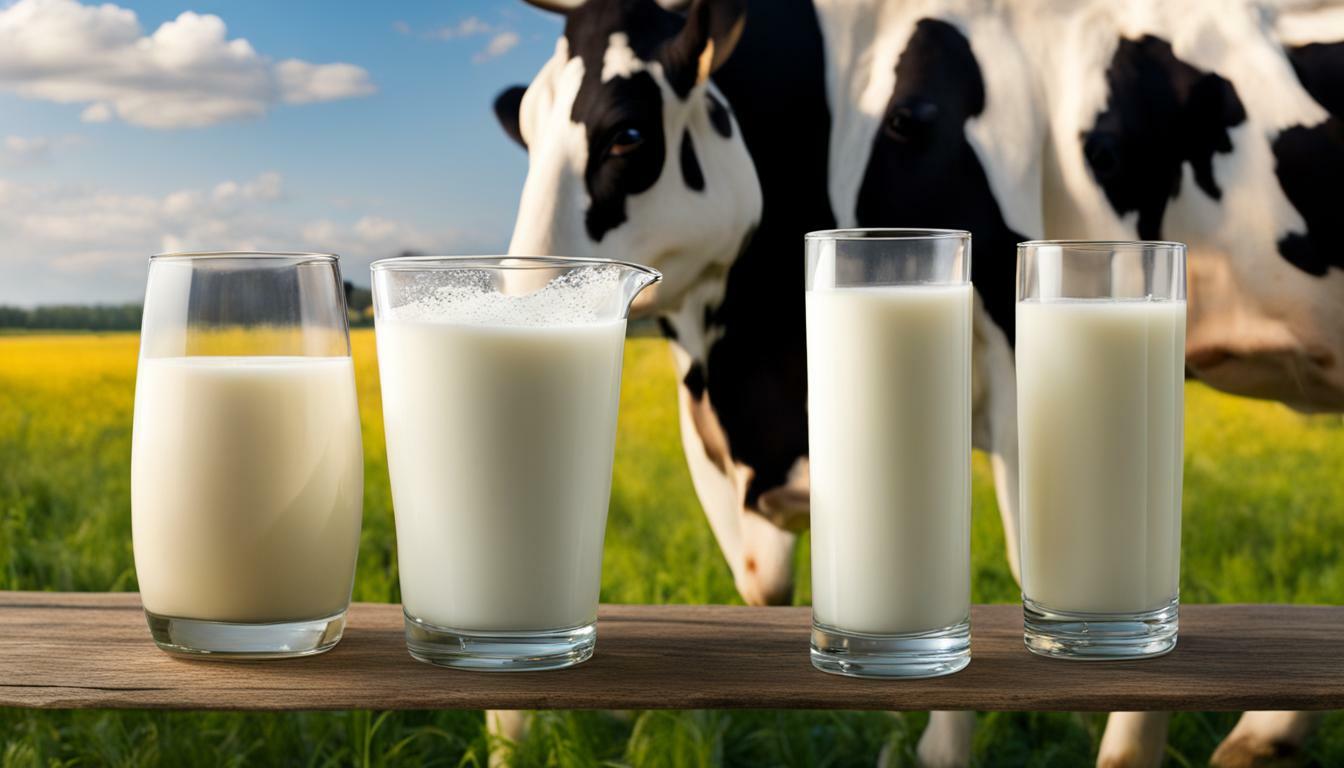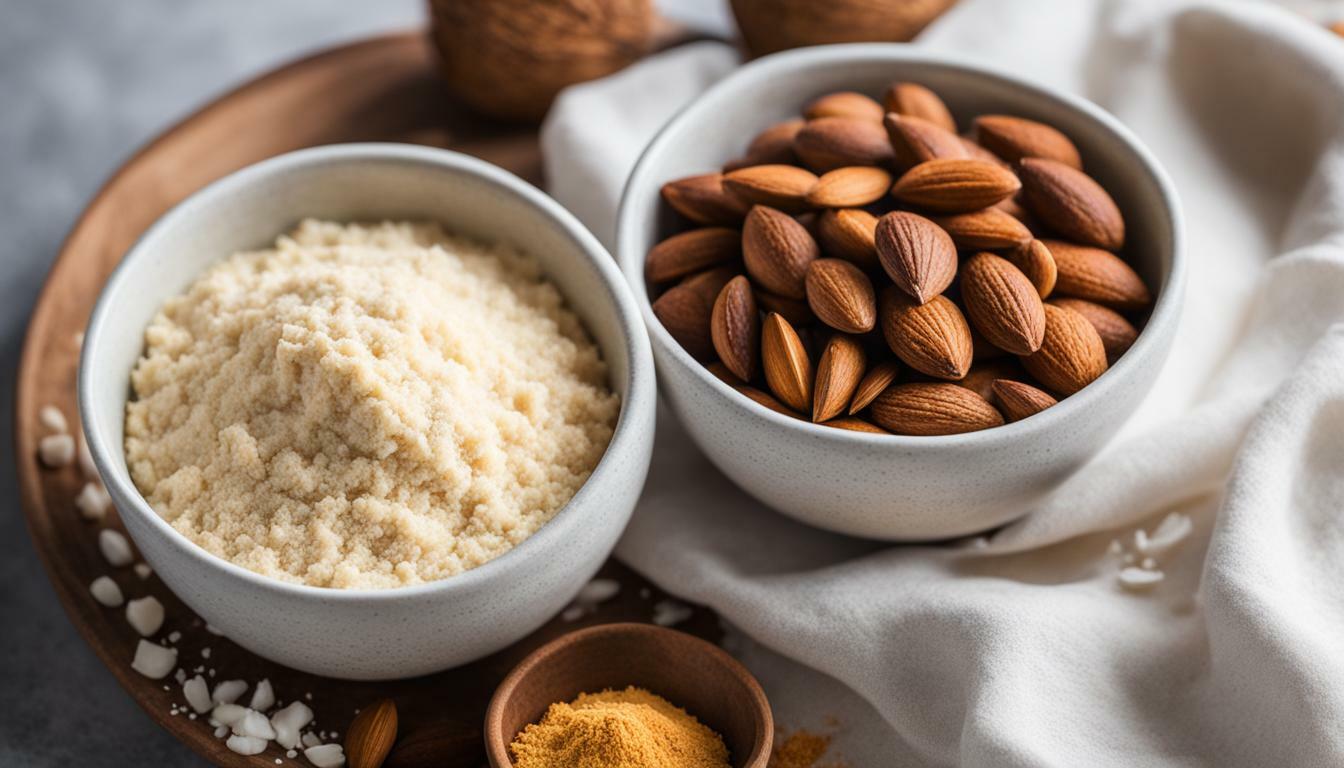When it comes to selecting milk for your daily routine, there are various options available in the supermarket. Two of the most popular types of milk are whole milk and skim milk. While both types of milk come from cows, there are significant differences between the two. Let’s take a closer look at the difference between whole milk and skim milk.
Key Takeaways:
- Whole milk and skim milk are two types of milk available in the market.
- Whole milk contains more fat, calories, and nutrients compared to skim milk.
- Skim milk has a lower fat content and fewer calories, making it a popular choice for individuals looking to reduce their calorie and fat intake.
Nutritional Differences Between Whole Milk and Skim Milk
When it comes to the nutritional value of milk, there are some key differences between whole milk and skim milk. Let’s take a closer look at how these two types of milk compare in terms of calorie content, fat content, protein content, as well as their vitamin and mineral profiles.
One cup of whole milk contains around 150 calories, while one cup of skim milk contains around 90 calories. This is because whole milk contains more fat than skim milk. In fact, whole milk contains about 8 grams of fat per cup, while skim milk contains only 0.2 grams of fat per cup.
When it comes to protein content, both whole milk and skim milk provide a good source of this essential nutrient. One cup of whole milk contains around 8 grams of protein, while one cup of skim milk contains around 9 grams of protein.
Whole milk also contains more vitamins and minerals than skim milk. For example, whole milk contains more vitamin D, vitamin A, and calcium than skim milk. Vitamin D is important for bone health, while vitamin A plays a role in maintaining healthy skin and eyes. Calcium is essential for building and maintaining strong bones and teeth.
However, if you are looking to reduce your calorie and fat intake, skim milk may be the better choice for you. Skim milk still provides a good source of protein and essential vitamins and minerals, while containing less calories and fat than whole milk.
Flavors and Textures of Whole Milk and Skim Milk
When it comes to the taste and texture differences of whole milk and skim milk, there are some notable variations between the two. Whole milk has a richer, creamier taste due to its higher fat content. On the other hand, skim milk has a lighter and more watery consistency, which some people prefer for its refreshing quality.
The flavors of whole milk and skim milk can also impact the taste of recipes in different ways. For example, whole milk can add a more decadent flavor to baked goods and creamy soups, while skim milk may be better suited for lighter dishes like smoothies or protein shakes.
When it comes to texture, whole milk is more dense and can provide a fuller mouthfeel while skim milk has a more delicate consistency because of its lower fat content.
Suitable Uses for Whole Milk and Skim Milk
Whole milk and skim milk are versatile ingredients that can be used in a variety of ways in the kitchen. Here are some suitable uses for each:
Whole Milk
- Drinking on its own
- Adding creaminess to coffee, tea, and hot chocolate
- Making rich and creamy sauces for pasta dishes and casseroles
- Baking cakes, cookies, and other desserts
- Making homemade ice cream and whipped cream
Skim Milk
- Drinking on its own
- Adding to smoothies for a low-calorie boost of nutrition
- Using in recipes that require a lighter consistency, such as soups, stews, and gravies
- Reducing the calorie and fat content of dishes like mashed potatoes and mac and cheese
- Making low-fat versions of puddings, custards, and other desserts
Overall, the suitability of whole milk or skim milk in a particular recipe will depend on the desired flavor, texture, and nutritional profile. By understanding the unique characteristics of each type of milk, you can choose the one that is best suited for your culinary needs.
Health Benefits of Whole Milk and Skim Milk
Both whole milk and skim milk offer different benefits to the body, making them good choices depending on individual needs and preferences.
Benefits of Whole Milk
Whole milk is rich in essential nutrients such as calcium, vitamin D, and potassium. These nutrients are important for building strong bones, regulating blood pressure, and supporting cardiovascular health.
In addition, the fat content in whole milk can help promote satiety and prevent overeating, which may be helpful for individuals looking to maintain a healthy weight.
Some research has also suggested that consuming full-fat dairy products like whole milk may be associated with a lower risk of obesity and type 2 diabetes, although more studies are needed to confirm these findings.
Benefits of Skim Milk
Skim milk is a low-calorie, low-fat alternative to whole milk. It contains all the essential nutrients found in whole milk, but with significantly fewer calories and less fat.
For individuals looking to reduce their calorie and fat intake, skim milk can be a good option. It can also be a useful ingredient in recipes that require milk, without adding extra calories and fat.
Some studies suggest that consuming low-fat dairy products like skim milk may be associated with a lower risk of heart disease and stroke, although more research is needed to confirm these findings.
Overall, both whole milk and skim milk have their own unique benefits and can be a part of a healthy diet. It is important to consider individual dietary needs and preferences when choosing between the two.
Conclusion
After exploring the differences between whole milk and skim milk, it is clear that each has its unique advantages and disadvantages. For individuals looking to reduce their calorie and fat intake, skim milk may be the better choice. However, those seeking essential nutrients and satiety may benefit more from whole milk.
When it comes to weight loss, the choice between whole milk and skim milk will depend on individual dietary needs and preferences. Both types of milk can be incorporated into a healthy and well-balanced diet, and moderation is key.
Overall, the decision of which is healthier between whole milk and skim milk is subjective. It is important to consider individual nutrition needs and goals when choosing between the two. So, whether you prefer the creamy texture of whole milk or the lighter consistency of skim milk, both can be enjoyed in moderation as part of a healthy lifestyle.
 Skip to main content
Skip to main content


